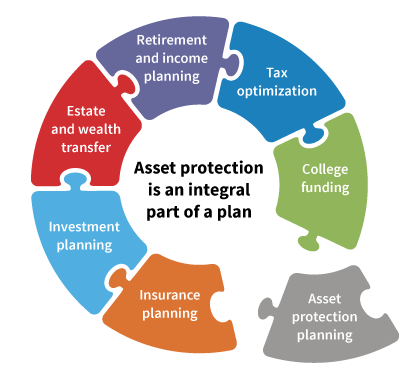While investors tend to focus on risk around markets, inflation, and other areas, they often overlook a serious risk to their net worth — creditor risk. As a result, many do not carry adequate or excess insurance coverage.
A recent survey from Chubb found that 10% of high-net-worth families had to pay legal judgments of at least $100,000. Only 10% of respondents had excess liability coverage.
Investors may be able to mitigate their exposure to creditor risk by implementing asset protection strategies as part of a comprehensive financial plan.

Protecting assets is often an after-thought
A leading misconception is that only certain professionals, such as physicians or small-business owners, need to worry about creditor risk. However, investors with comparatively modest financial assets, such as a home or retirement savings, also should consider asset protection. Claims and lawsuits stemming from car accidents, personal injury on your property, and liabilities involving family members can place assets at risk. Actually, nearly all investors need at least a fundamental plan to protect assets from potential creditors or in the event of bankruptcy.
Many investors believe that coverage from homeowner’s or automobile insurance will be adequate. But in many situations, it is not enough.
It is important to shield assets before something happens. Asset protection can help investors maintain their standard of living and preserve their ability to pass assets to heirs.
Assess current coverage
Insurance forms the foundation for most asset protection plans. A first step involves reviewing existing home and auto policies to make sure there is adequate liability coverage in case of some type of accident or event. Typically, the additional cost to increase underlying liability coverage in these policies is modest.
For auto policies, states regulate the minimum amount of liability coverage per person and per accident.
For example, “25/50” coverage means that up to $25,000 per person is covered with a total of $50,000 for the entire accident. This is the most prevalent minimum coverage amount required by states.
Homeowner policies are not regulated by states like auto policies, but most homeowner insurance policies provide a minimum of $100,000 worth of liability insurance, according to the Insurance Information Institute.
Consider umbrella insurance
Umbrella liability policies provide additional coverage in excess of auto and home policies, starting at $1 million worth of coverage. At the same time, umbrella policies require policyholders to maintain a certain minimum amount of liability coverage on auto and home policies, typically $250,000 on auto and $300,000 on home.
How umbrella insurance works in concert with other coverages:
- For example, in the case of a claim as a result of an accident at home, the home policy would cover the first $300,000 in liability and the umbrella policy would cover additional liability up to $1 million
- If you purchase an umbrella policy and don’t maintain the required minimum on auto/home policies you would be liable for that gap in coverage
- Depending on net worth, clients may consider increasing their umbrella policy coverage to $2 million, $5 million, etc, depending on the level of wealth and risk profile
- It is important to note that some policies may extend coverage to activities while volunteering for a non-profit entity. Commercial or malpractice coverage is needed for potential liability related to business activities
Asset protection is an important part of a financial plan
Extra insurance coverage is an important consideration for any comprehensive financial plan, and investors may want to review their current insurance coverage with a financial advisor and discuss establishing an asset protection plan. Consultation with insurance and legal professionals may also be needed to implement a comprehensive plan.
To learn more about asset protection strategies, read Putnam’s investor education piece, “Asset Protection: Basic principles and strategies for safeguarding your wealth.”
313560
For informational purposes only. Not an investment recommendation.
This information is not meant as tax or legal advice. Please consult with the appropriate tax or legal professional regarding your particular circumstances before making any investment decisions. Putnam does not provide tax or legal advice.





